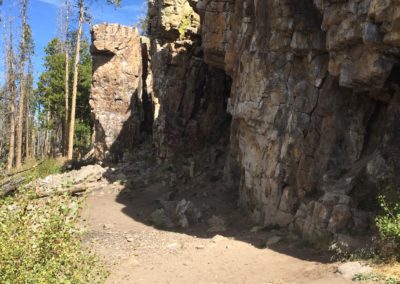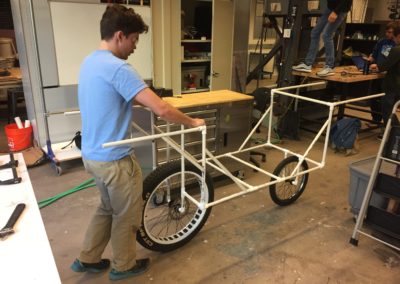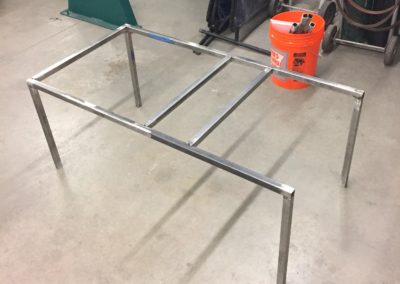HCDS – Backcountry Rickshaw
Overview
The Breckenridge Outdoor Education Center (BOEC) approached the Human Centered Design Studio with the challenge of transporting people with mobility limitations over rough terrain to a climbing crag. Existing solutions create an unpleasant and inconvenient experience for the users and the assistants. Thus, the Backcountry Rickshaw was born.
Anyone who has experienced rock climbing in Colorado can appreciate the challenge of getting to the crag. Weighed down by ropes, gear, and supplies, the approach can be challenging for anyone. Climbing areas are often exposed and subjected to frequent unexpected storms; wet dirt and rock can make the trails even more difficult.
The Backcountry Rickshaw is designed to enable adaptive climbers to get to the crag with assistance of BOEC personnel. Large inline wheels, a hydraulic disk brake, and comfortable ergonomics address the challenges that face assistants. A comfortable and secure seat, foot platforms and a smoother ride address challenges faced by users.
Documented below are the prototypes, iterations, and analysis undertaken by the team during the design of the Backcountry Rickshaw.
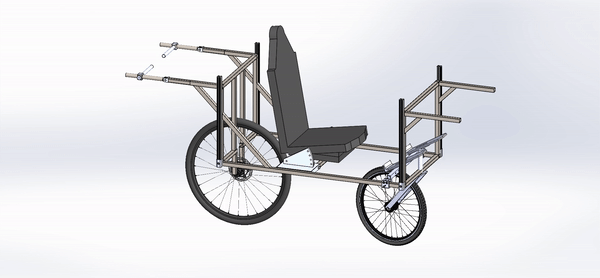
PVC prototype
This is an early PVC prototype created by the team to test the rickshaw geometry in order to support as many users as possible.
Team Members
- Colin McIllece
- Charlie Koch
- Cassandra English
- Jack Doherty
- Ian Blythe
Advisors
- Jamie Overmeyer, BOEC
- Dr. Chelsea Salinas, School of Mines
- Dr. Joel Bach, School of Mines
Client
Acknowledgements
Elevator Pitch
Here at the Colorado School of Mines, a school located adjacent to the Rocky Mountains, we love outdoor recreation. Hiking, biking, climbing, skiing: students here do it all. The goal of this project is to bring the outdoors to people who have previously had limited access due to physical limitations. We want to bring outdoor mobility to people with ambulatory challenges so that they too can experience activities such as rock climbing.
Mobility in an outdoors environment requires much more than a wheelchair. The dual inline wheel design with a front caster exhibits excellent longitudinal stability, a low center of mass, and a significantly reduced turning radius. Careful design optimization and FEA also yields a product that is significantly lighter than competing designs.
The rickshaw also holds the user experience first and foremost. The rickshaw has easily adjustable foot platforms and seat, meaning that it can quickly be set-up for a wide range of users. Innovative handle designs were also made to allow for the rickshaw to be leveraged up rocks that are all too common on trails while still allowing for easy transport in a folded-up state, meaning that the rickshaw is always ready for action!
Design Approach
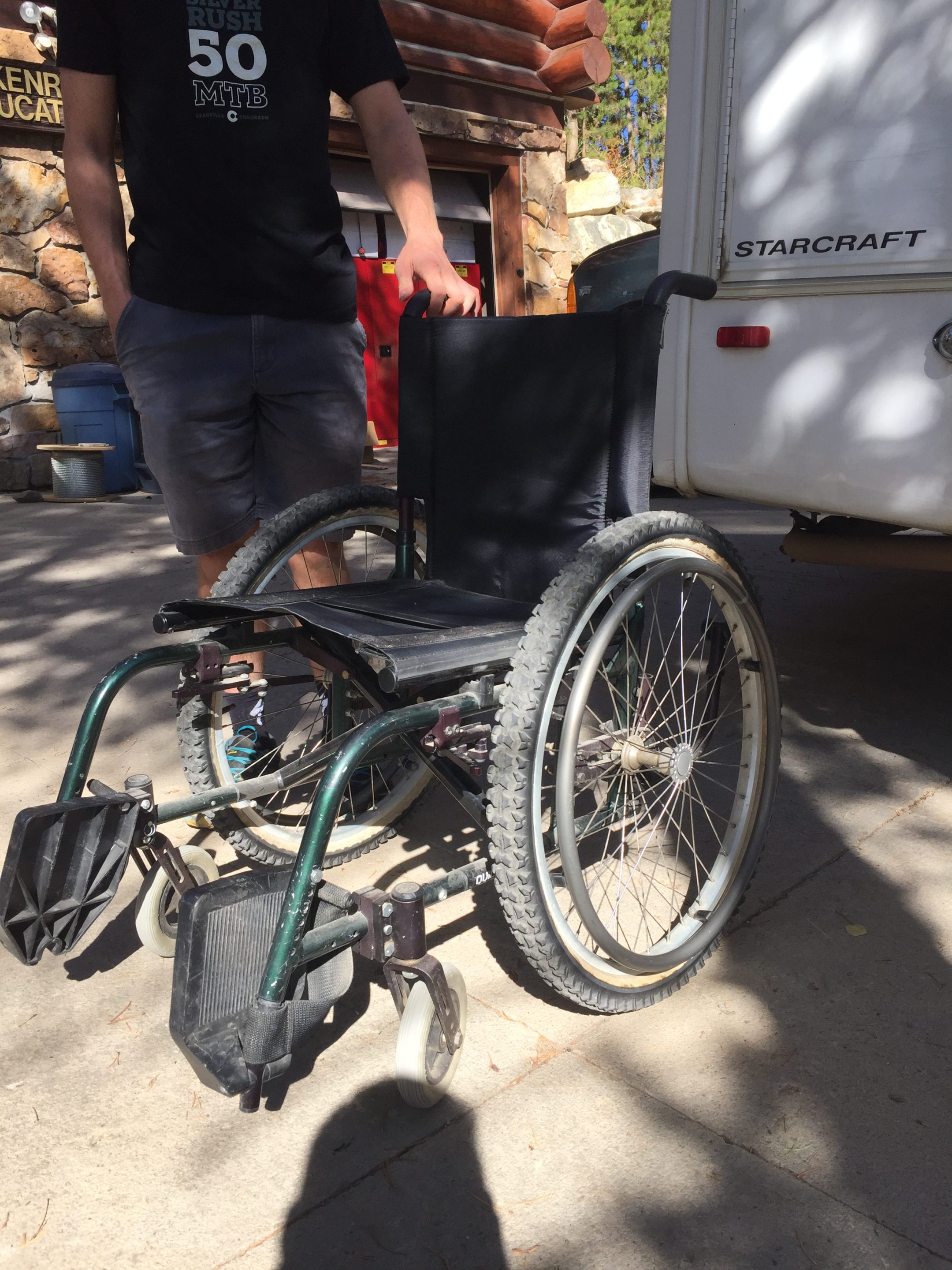
Current BOEC “Backcountry wheelchair” Solution
The client, the Breckenridge Outdoor Education Center (BOEC) currently uses two less than ideal solutions, the first being a “Mountain” wheelchair, and the second being a product called the Hippocampe. The Mountain wheelchair is a standard wheelchair modified with 26” mountain bike wheels and the Hippocampe is an expensive and underperforming product. Both current solutions are very limited and are marginally better than using a normal wheelchair.
After talking with the client, it became clear that any solution would need to achieve the following:
- The ability to navigate technical and slippery terrain
- The ability to hold the user securely and comfortably, protecting them in the event of a tip over
- A reasonably light weight
- Adjustability for a variety of users
- Provide an easy transfer to and from wheelchairs
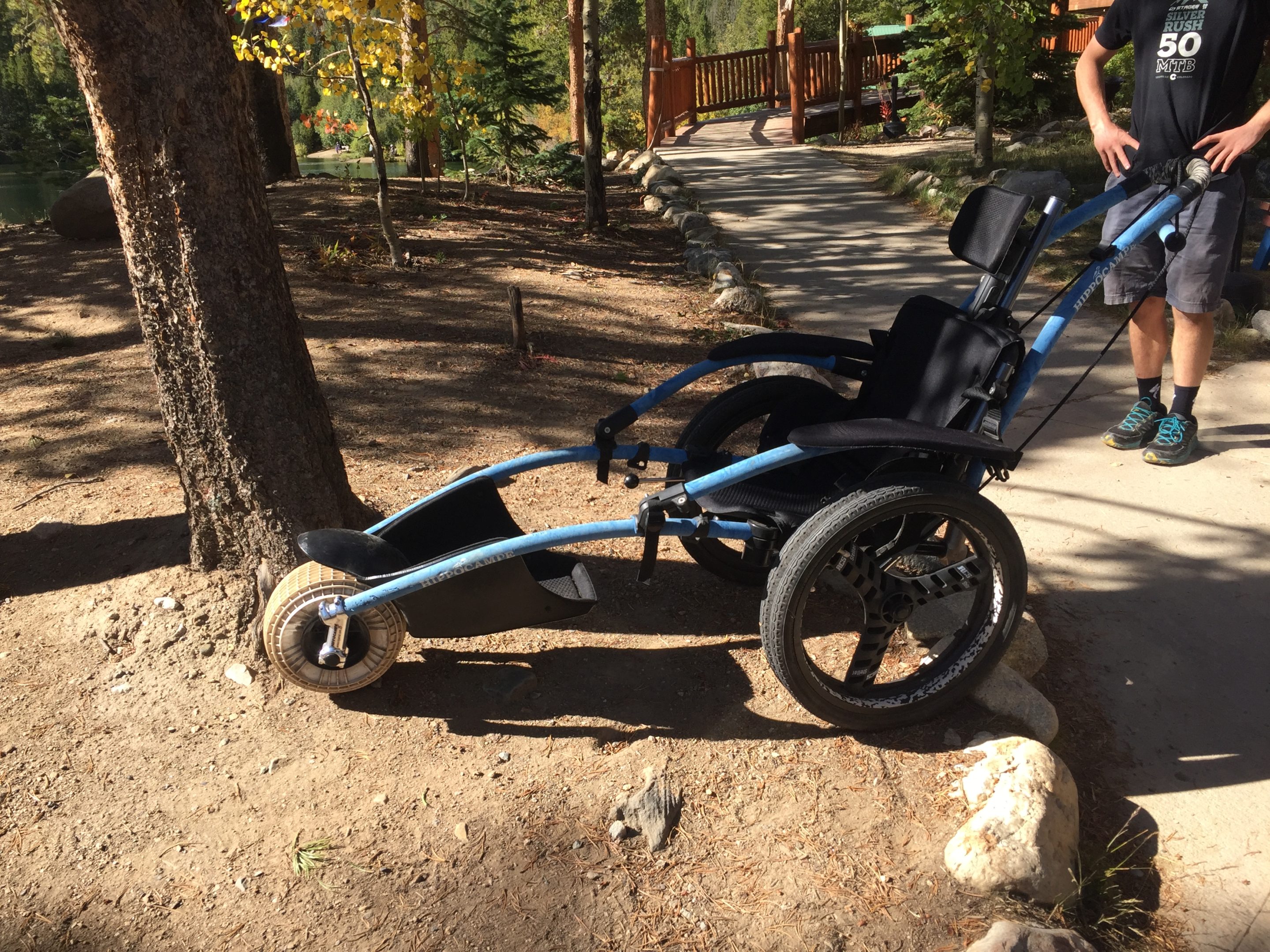
Current BOEC Hippocampe Solution
Our project solution was initially conceptualized as similar to the Joelette and University of Utah prototype with a single wheel underneath the user. This was seen as the simplest solution available. However, upon analyzing several different solutions in a design matrix, we realized we could provide the BOEC with an even better product to meet their needs. Our winning design uses two inline wheels, the rear wheel being a large “fatbike” wheel, and the front wheel using a caster. This solution offers several key advantages. The first is the ability to leverage the rickshaw over obstacles by tilting one wheel and then the second over it. This minimizes the weight experienced by the user’s assistants during this process, contrary to the Joelette design where the full weight of the user and rickshaw must be lifted. The second advantage is lowering the user’s seat height. As the user is not directly over a single wheel, the height can be lowered much further. This both increases the ease of transferring the user from a wheelchair, and provides more protection to the user by minimizing the distance the rickshaw could tip over.

Joëlette Design

University of Utah’s prototype
Design Solution
The team leaned heavily upon shared experience and interest in Mountain Bike technology throughout the design of the Backcountry Rickshaw. Basing key design features off of mountain bikes allowed the team to utilize established technology such as wheels, brakes, and grips. This design approach allowed the team to spend more time focusing on key, novel features such as the frame, seat and foot platforms, assistant interface, and client needs.
Frame
The frame is built of 1 inch steel tubing. Chosen due to its high strength, good joining properties, and low cost. The frame must provide safety for the user, the ability to support heavy loads being moved over rough terrain, comfortable ergonomics for assistants, all while minimizing weight. Several iterations were conducted which were instructed by FEA stress tools, client feedback, and team discussions.

Rickshaw Frame
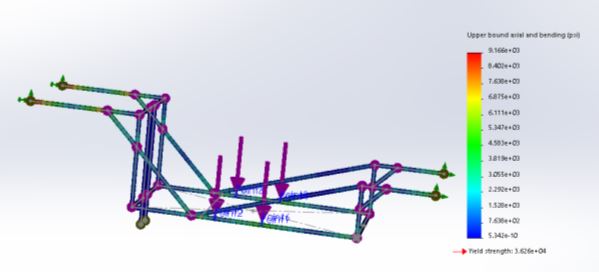
Rickshaw Upper Bound Axial FEA (psi)
Handles and Brakes
The way that the user’s assistants will interface with the Rickshaw is through the handles. Designed for 1 or 2 assistants who will push from the back, and pull from the front. The rear handles needed to be strong, adjustable, and interface with the brakes. Additional considerations were the client limitations on total length of the system. Rather than sacrifice user comfort, a hinge system was designed for the handles to allow them to be folded down during transport. A hydraulic disk brake lever is to be mounted to the handles to allow for progressive stopping power to maintain control during a descent.
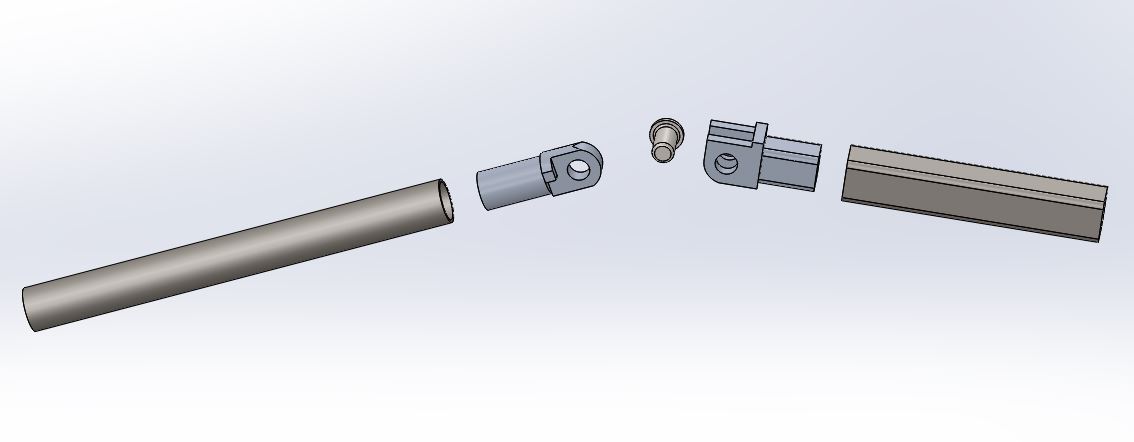
Adjustable handles subsystem
Foot platforms
The ride might get bumpy! One critical design consideration was a way to support the user’s feet and legs – preventing interference with the front wheel, and keeping them contained in case of a tip over. Foot supports are also crucial to prevent the seat from cutting off the user’s blood flow at their legs. Foot platforms were modeled after those of a rowing machine, with straps to gently hold user’s feet while still allowing easy entry and exit to the rickshaw.
The design was driven by the goal of allowing the easiest possible operation for the user. This meant that the system must easily slide along the rickshaw frame so that different leg lengths can easily be accommodated. After working through several possible designs, a set-screw and bearing slider design was chosen. This design supports the weight of the assembly on four radial ball bearings so that there is limited friction and binding when sliding the foot flatforms along the rails.
This design also has the benefit of making the entire sub-assembly easily removable from the rickshaw by simply removing four bolts. This means that future adjustments and iterations on this sub-system can easily be carried out.
The foot platforms themselves were also designed for a simple adjustment. The upper nylon footrest slides along a fixed support by simply loosening two bolts. Since the strap is attached to the fixed support, this allows for a very simple way of locating the strap across the center of different sized feet.
Finally, the stance of the foot platforms is adjustable by moving the nylon support piece to different bolt holes. This adjustment is slightly more cumbersome, but should rarely need adjustment. Overall, modularity and adjustability drove the design of this subsystem and the end result is foot platforms that can accommodate a wide range of users.

Foot Platform subsystem
Caster Wheel
Stability and maneuverability were key design considerations. The rake angle of the caster was carefully determined to ensure the user assistants would be able to guide the rickshaw down the trail with control while still allowing them to make tight turns and reverse direction. Designing to avoid caster flutter was also an essential consideration. Using a long swivel lead and a pneumatic tire with a high coefficient of friction at the contact patch and material damping properties largely eliminated the caster flutter problem.
Caster wheels operate on the principle of the mechanical trail, where friction at the contact patch causes a moment that aligns the wheel with the direction of travel. Optimizing this mechanical trail value was extremely important for the design so that the rickshaw could be maneuvered while still maintaining stability. Increasing the trail value of the caster wheel causes more stability but sacrifices maneuverability. These two factors were balanced out to create optimal handling characteristics for the rickshaw.
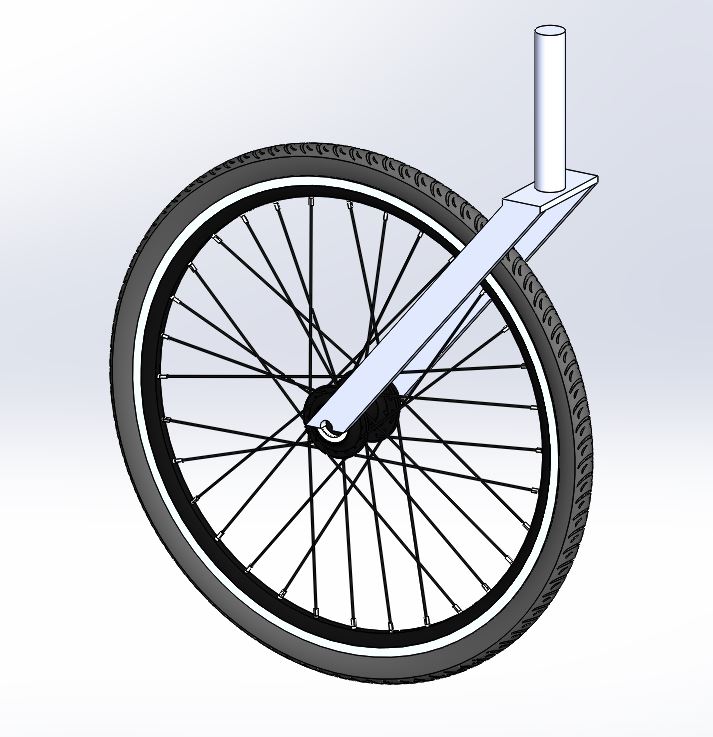
Caster Wheel subassembly
Idle Stand
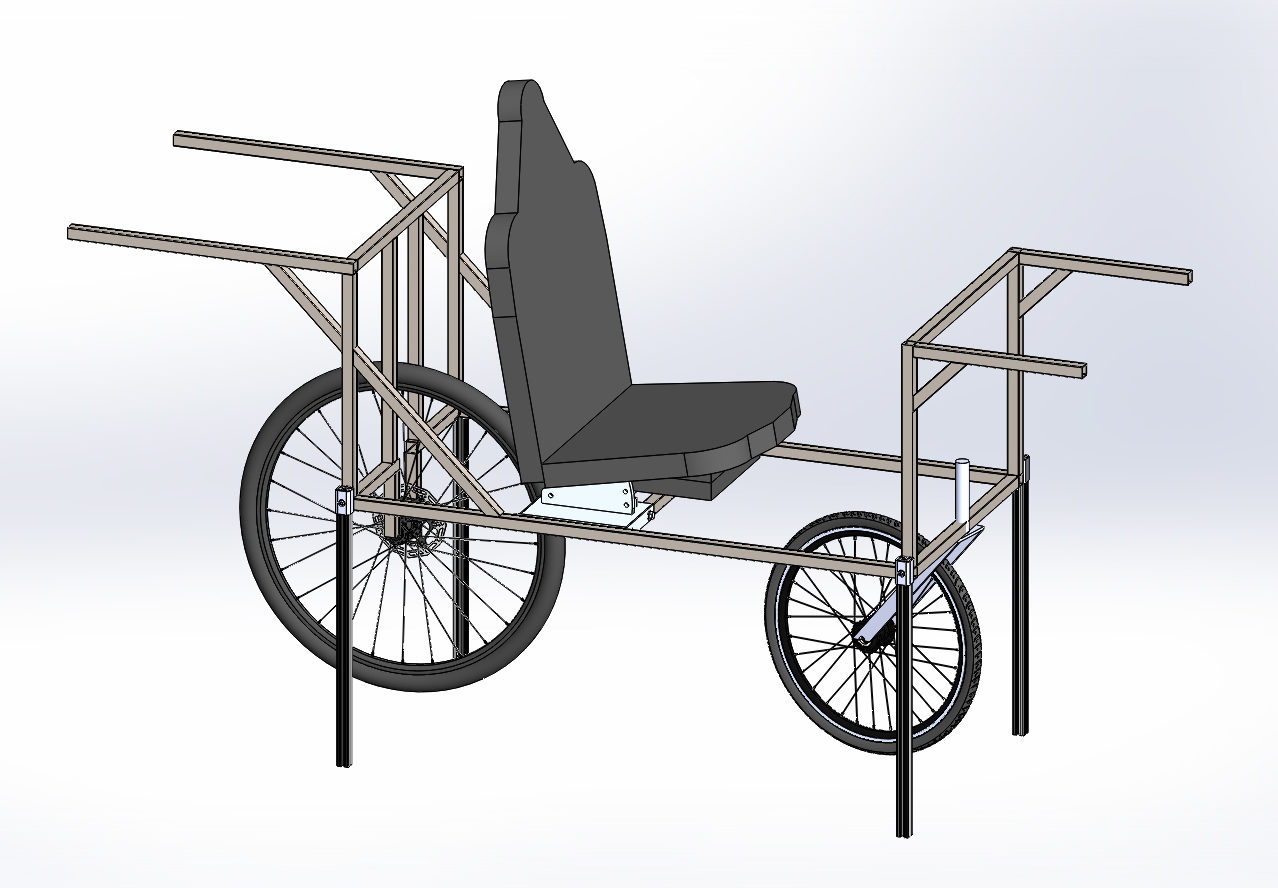
Idle Stand subsystem deployed
Next Steps
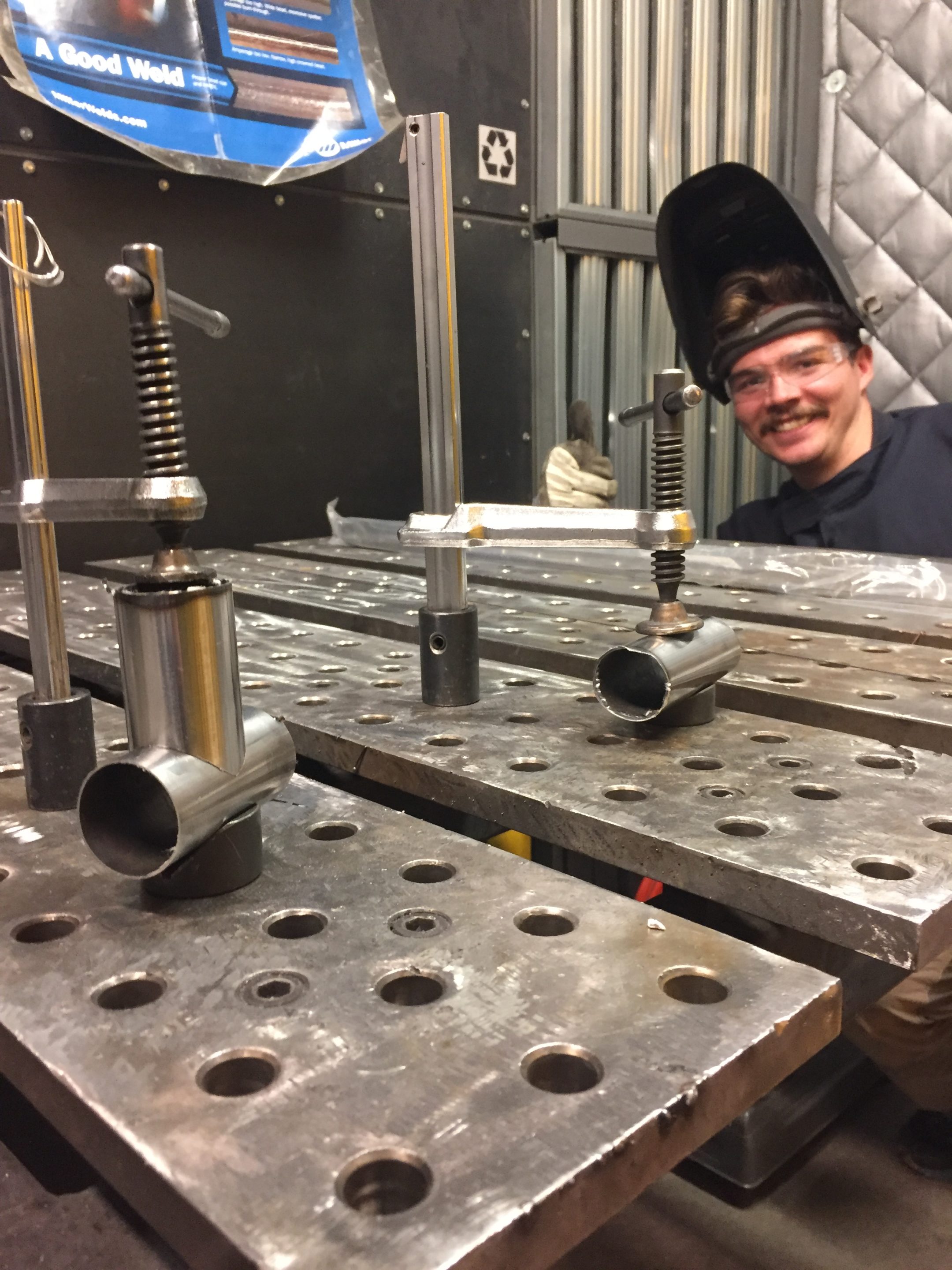
Charlie getting his TIG on to practice on thin-walled steel
Most of the remaining work on the Rickshaw lies in the physical build. The team was cut short in the middle of welding the frame together and finalizing CNC programs for other subsystem parts.
The next steps for the Rickshaw fabrication include:
- Finish welding the frame
- Machine foot platform subsystem
- Machine seat mount subsystem
- Finalize design on front caster wheel and weld to frame
After fabrication the Rickshaw will be thoroughly tested to ensure that it meets or exceeds client requirements. If the initial design falls short of expectations then further design and build iteration will occur so that the BOEC receives the correct solution for its needs.
Meet the Team
Charles Koch
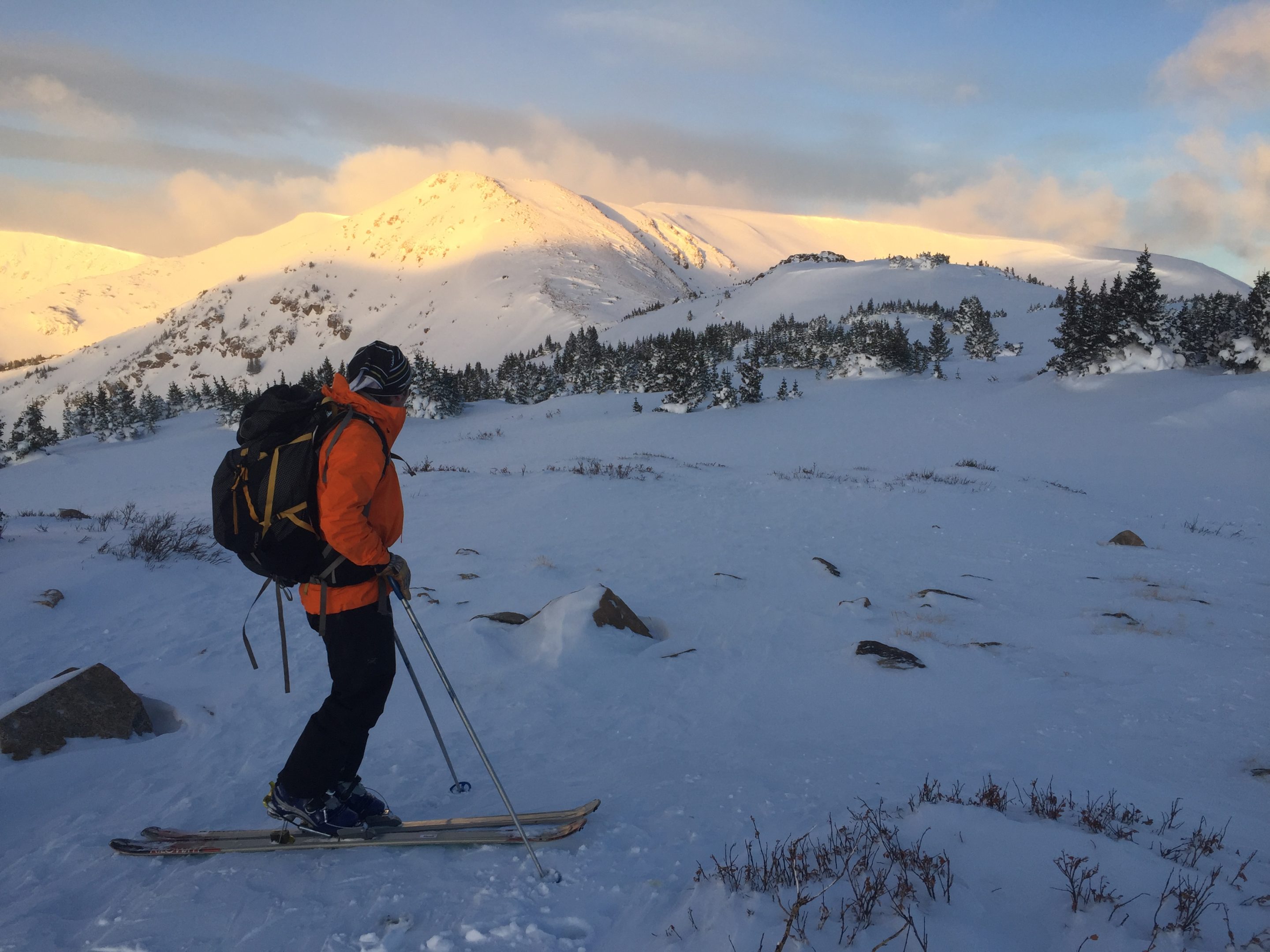 Charles Koch is a graduating senior in Mechanical Engineering at Mines. A love of outdoor recreation including backcountry skiing and cycling led Charles to the Human Center Design Studio for his senior design project.
Charles Koch is a graduating senior in Mechanical Engineering at Mines. A love of outdoor recreation including backcountry skiing and cycling led Charles to the Human Center Design Studio for his senior design project.
Cassandra English
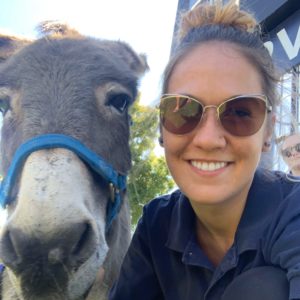
Jack Doherty
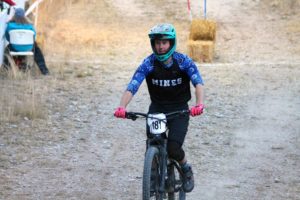 Outside of HCDS, Jack has gained experience with engineering through work at Specialized Bicycle Components in Morgan Hill, California. While at Specialized, he worked on data acquisition systems for analyzing suspension performance and gained valuable hands-on design and build experience. When not working on engineering projects, you can find him riding bikes (likely with other members of this team).
Outside of HCDS, Jack has gained experience with engineering through work at Specialized Bicycle Components in Morgan Hill, California. While at Specialized, he worked on data acquisition systems for analyzing suspension performance and gained valuable hands-on design and build experience. When not working on engineering projects, you can find him riding bikes (likely with other members of this team).
Colin McIllece
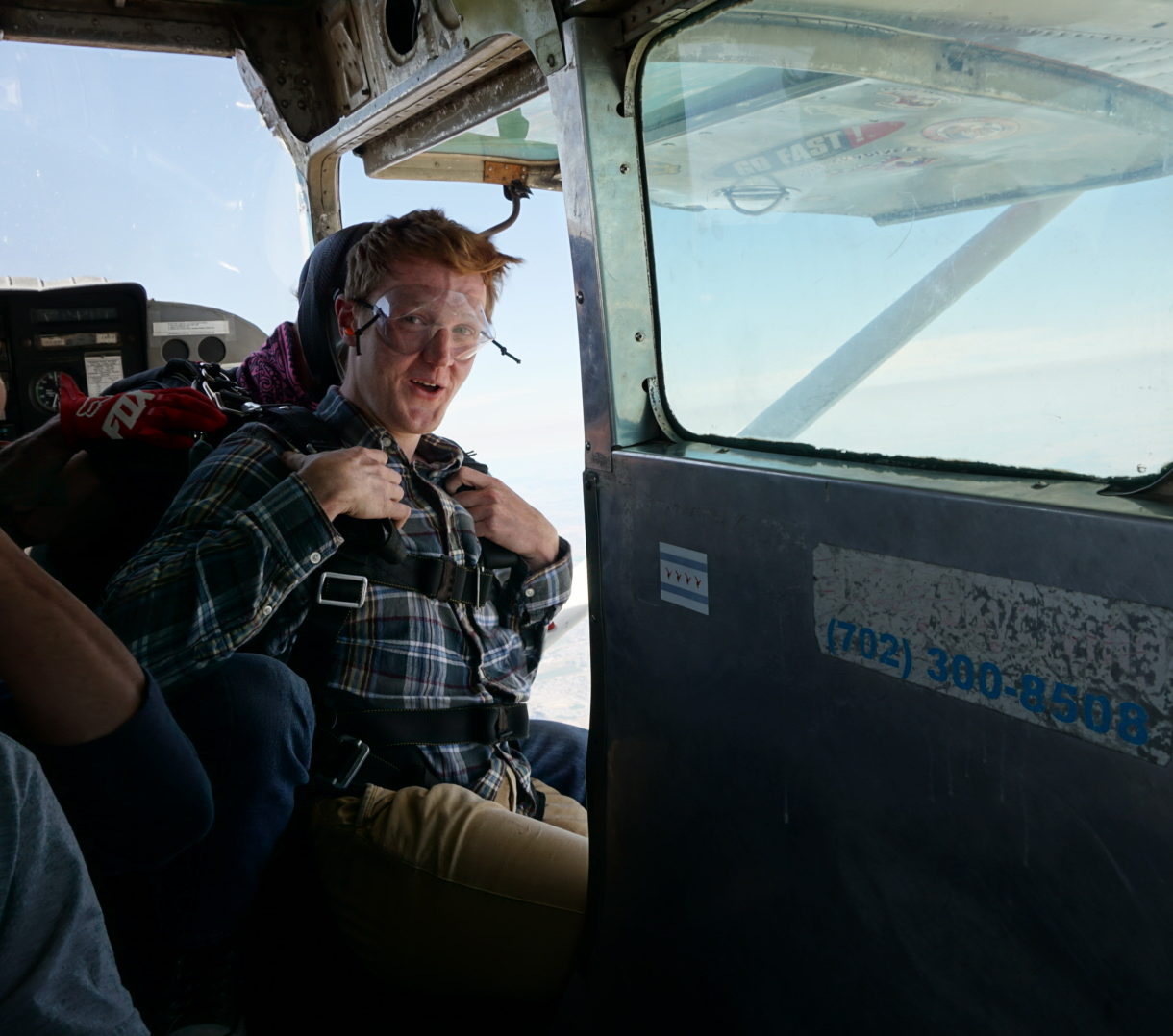 Colin is a graduating senior in Mechanical Engineering at Mines. He is the President of the Mines Bicycle Design and Fabrication Club and is always looking for a big project to get involved with. His most recent is an offroad teardrop trailer camper! Some of his hobbies outside of school are hiking, mountain biking, motorcycling, skiing, and design and fabrication.
Colin is a graduating senior in Mechanical Engineering at Mines. He is the President of the Mines Bicycle Design and Fabrication Club and is always looking for a big project to get involved with. His most recent is an offroad teardrop trailer camper! Some of his hobbies outside of school are hiking, mountain biking, motorcycling, skiing, and design and fabrication.
After graduation, Colin will be working for the Sierra Nevada Corporation, an aerospace integrator in Centennial, CO.
Ian Blythe
 An atypical student, Ian started college at 26 after an international career as a professional motorcycle racer. A deep seated love of machinery and engines sparked an interest in engineering which has been nurtured at Mines. A second passion for the outdoors, manifested in endurance mountain bike racing. Deriving joy through recreation drew Ian to the Human Centered Design Studio where he is helping to bring mobility and access to the outdoors through the Back Country Rickshaw project.
An atypical student, Ian started college at 26 after an international career as a professional motorcycle racer. A deep seated love of machinery and engines sparked an interest in engineering which has been nurtured at Mines. A second passion for the outdoors, manifested in endurance mountain bike racing. Deriving joy through recreation drew Ian to the Human Centered Design Studio where he is helping to bring mobility and access to the outdoors through the Back Country Rickshaw project.
